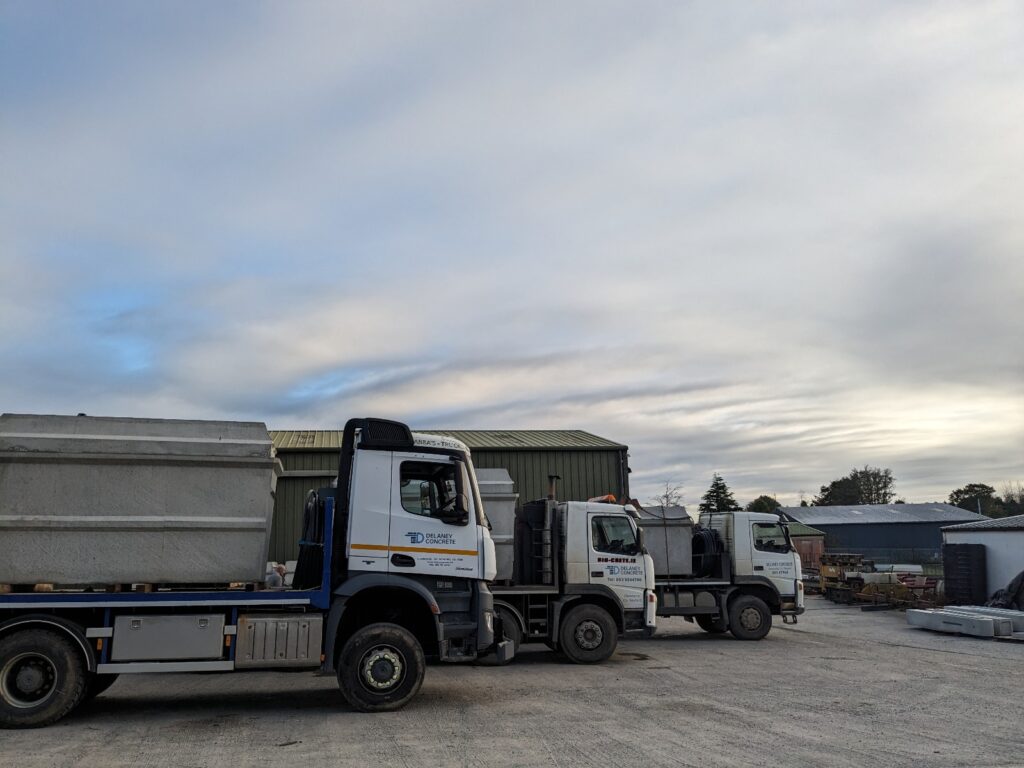
Installation Guide
Site Access and Preparation
Installation of our tanks is a team effort, your digger driver prepares the pipework around the house and digs the hole. We then bring the tank on one of our lorries and reverse up to the hole. We have rear lorry mounted cranes with which we use to lift the tank off of the back of the lorry into the hole. It is important to ensure the site is in such a condition that we can get to the hole, that may include removing hazards or laying down stone for the lorry to drive on. The digger driver must always be present when we are lifting in the tank so that if the hole needs adjusting they are on hand.
The Fall on your Pipes
Please do not put more fall on your pipe than is necessary.
The fall on the pipes from the house to the tank should be 1:60. Once the effluent has been treated in the tank and there are no longer large solids in the pipework, a shallower fall is acceptable. A fall of 1:200 is suitable for percolation pipes.
The fall on pipes is described as a ratio. A fall of 1:60 means a drop of one metre in depth for every 60 metres in length or a fall of 1 foot in depth for every 60 feet in length.
Tank Level
The depth of your inlet pipe is what determines the depth of the tank in the ground. For example, if your inlet pipe is only 150mm below ground level you are unlikely to need risers but if the inlet pipe is 1 metre below ground level then you would need to add risers to the top of your tank. The top of your tank should be >25mm above your finished lawn level. This is to prevent surface water entering the tank through the lids and vents. Risers are extension pieces which are fitted to the tank in order to bring the tank lids up to ground level. When you are ordering a tank be sure to keep us informed of your need for risers.
Risers
Risers are extension pieces for your tank which bring the tank lids back up to ground level when you’re tank is below ground level. This is required for access, maintenance, and desludging. Risers should be fitted at the same time as the tank is delivered, and should be sealed onto the tank to prevent groundwater from entering the tank. Ground water entering the tank can cause your pumps to be overworked and therefore shorten their lifespan. It can also lead to percolation area problems as your percolation area can become overloaded.
T-Pieces
It is very important to ensure that T-pieces in tanks are correctly installed. A healthy septic tank or treatment plant has a natural crust on the first/primary chamber, which is needed to keep away unwanted odours. The septic tank inlet T-piece is to allow the waste to enter the first chamber without disturbing or breaking the crust and therefore avoiding smells in the garden.
The outlet T-piece is even more important on septic tanks as it prevents solids moving out into your percolation area. As solids move into the last chamber of your tank the majority of solids will either float or sink so you want to draw the water to the centre of the tank to prevent as many solids as you can moving out to your percolation area and potentially blocking up the pipes and the stone in the trenches.
Base of Excavation and Backfilling
All Delaney Concrete Tanks have a 75mm thick concrete floor, therefore no special base is required in the excavation, the tank can sit directly onto the soil at the bottom of the excavation. If the base of your excavation consists of bedrock, shale, or other stone material a layer of sand or pea gravel should be spread across the base of the excavation. This provides a cushion between the tank and the underlying rock, preventing any stress points being created by large angular stones under the tank.
The excavation should be backfilled as soon as possible, and generally, the soil that was excavated can be used for backfilling. No stone, large boulders or large rocks should be used when backfilling.
Sealing your Tank
With changing weather patterns, ground water ingress is a significant issue if your tank is not properly sealed. When the installer or ground worker installs the inlet pipe care should be taken to ensure that the area around the pipe is fully sealed. Similarly, in treatment plants the power cable inlet must be sealed. If risers are fitted and the water table is higher than the height of the risers, then sealer should be used at the time of installation of the risers.
Enquire now for wastewater septic tank and treatment plant solutions for your home or business
Phone: +353 (0)53 9244767
Complete the quick contact form below and we will call you back shortly.

